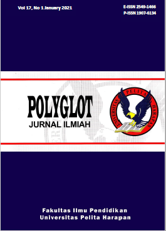PENGARUH PEMBELAJARAN JARAK JAUH MODEL BAURAN TERHADAP HASIL BELAJAR DAN PERSEPSI MAHASISWA [THE EFFECT OF THE BLENDED LEARNING MODEL ON STUDENT LEARNING OUTCOMES AND PERCEPTIONS]
DOI:
https://doi.org/10.19166/pji.v17i1.2792Λέξεις-κλειδιά:
distance learning, blended learning, student learning outcomes, student perceptions, pembelajaran jarak jauh, pembelajaran bauran, hasil belajar, persepsi mahasiswaΠερίληψη
This study aims to determine whether distance learning can effectively be implemented. This study compares the blended model of distance learning to traditional learning. The comparison is related to students’ learning outcomes and their perceptions of the two different learning models. This research is a quantitative study using a quasi-experimental research design with a time-series model. The population of this research was all fourth semester students who took digital electronics courses. Data collection was carried out in two ways: first, by using several tests to gather data on learning outcomes and, second, by giving questionnaires to determine student perceptions. Data analysis was performed using the t test for paired (dependent) samples. This study revealed that there were statistical differences between blended learning and traditional learning (p < 0.05). This result also showed that the blended model of distance learning was more effective than traditional learning.
BAHASA INDONESIA ABSTRACT: Penelitian ini adalah bertujuan untuk mengetahui apakah pembelajaran jarak jauh efektif untuk diterapkan. Penelitian ini membandingkan antara pembelajaran jarak jauh model bauran dengan pembelajaran tradisional. Yang dibandingkan adalah hasil belajar mahasiswa dan persepsi mereka pada kedua pembelajaran ini. Penelitian ini adalah penelitian kuantitatif yang menggunakan desain penelitian quasi-eksperimen model time-series. Populasi penelitian ini adalah semua mahasiswa semester 4 yang mengikuti perkuliahan mata kuliah Elektronika Digital. Pengumpulan data dilakukan dengan dua cara yaitu dengan beberapa tes untuk data hasil belajar dan kuesioner untuk data persepsi mahasiswa. Analisa data dibuat dengan menggunakan uji t untuk sampel berpasangan (tak bebas). Hasil analisis uji t dan perbandingan mean diperoleh bahwa terdapat perbedaan pada kedua sampel rata-rata yang diuji dan pembelajaran jarak jauh model bauran memiliki rata-rata yang lebih tinggi dari pembelajaran tradisional (P<0.05). Hal tersebut menunjukkan bahwa pembelajaran jarak jauh model bauran adalah lebih efektif dari pembelajaran tradisional.
Αναφορές
Bruno, F. J. (2002). Psychology: A self-teaching guide. New York, NY: John Wiley & Sons.
Finkelstein, J. (2006). Learning in real time: Synchronous teaching and learning online. San Fransisco, CA: Jossey-Bass.
Graham, C. R. (2006). Blended learning systems: Definition, current trends, and future directions. In Handbook of blended learning: Global perspectives, local designs. San Fransisco, CA: Pfeiffer.
Kadir. (2016). Statistik terapan: Konsep, contoh, dan analisa data dengan program SPSS/Lisrel dalam penelitian. Depok, Indonesia: Rajawali Pers.
Kemdikbud. (2020). Kemendikbud terbitkan pedoman penyelenggaraan belajar dari rumah. Retrieved from https://www.kemdikbud.go.id/main/blog/2020/05/kemendikbud-terbitkan-pedoman-penyelenggaraan-belajar-dari-rumah
Kim, W. (2007). Towards a definition and methodology for blended learning. Retrieved from https://www.researchgate.net/publication/237798172_Towards_a_Definition_and_Methodology_for_Blended_Learning
Kintu, M. J., Zhu, C., & Kagambe, E. (2017). Blended learning effectiveness: The relationship between student characteristics, design features and outcomes. International Journal of Educational Technology in Higher Education, 14(1), 1-20. https://doi.org/10.1186/s41239-017-0043-4
Lim, C. P., & Wang, L. Blended learning for quality higher education: Selected case studies on implementation from Asia-Pacific. Bangkok, Thailand: UNESCO Bangkok Office.
Littlejohn, A., & Pegler, C. (2007). Preparing for blended e-learning. London, UK: Routledge.
Matthen, M. (2015). The Oxford handbook of philosophy of perception. New York, NY: Oxford University Press.
Miftah, M. (2013). Fungsi, dan peran media pembelajaran sebagai upaya peningkatan kemampuan belajar siswa. Jurnal Kwangsan, 1(2), 95-105. https://doi.org/10.31800/jkwangsan-jtp.v1n2.p95--105
Öhrstedt, M., & Lindfors, P. (2019). First-semester students’ capacity to predict academic achievement as related to approaches to learning. Journal of Further and Higher Education, 43(10), 1420-1432. https://doi.org/10.1080/0309877x.2018.1490950
Papadopoulos, T. C., Parrila, R. K., & Kirby, J. R. (2015). Cognition, intelligence, and achievement. Amsterdam, Netherlands: Elsevier Academic Press.
Rahman, A., & Ilic, V. (2019). Blended learning in engineering education: Recent developments in curriculum, assessment and practice. Boca Raton, FL: CRC Press.
Ratnawulan, E., & Rusdiana, H. A. (2014). Evaluasi pembelajaran: Dengan pendekatan kurikulum 2013. Bandung, Indonesia: Pustaka Setia.
Shadish, W. R., Cook, T. D., & Campbell, D. T. (2002). Experimental and quasi-experimental designs for generalized causal inference. Boston, MA: Houghton Mifflin.
Shahabadi, M. M., & Uplane, M. (2015). Synchronous and asynchronous e-learning styles and academic performance of e-learners. Procedia - Social and Behavioral Sciences, 176, 129-138. https://doi.org/10.1016/j.sbspro.2015.01.453
Sugiyono. (2014). Metode penelitian pendidikan: Pendekatan kuantitatif, kualitatif, dan R & D. Bandung, Indonesia: Alfabeta.
Sugiyono. (2015). Statistik untuk penelitian. Bandung, Indonesia: Alfabeta.
Syah, R. H. (2020). Dampak covid-19 pada pendidikan di Indonesia: Sekolah, keterampilan, dan proses pembelajaran. SALAM: Jurnal Sosial dan Budaya Syar-i, 7(5), 395-402. https://doi.org/10.15408/sjsbs.v7i5.15314
Tongkotou, J. (2019). Dosen fatek Unima kembangkan blended learning. Retrieved from http://www.komentar.co.id/2019/09/dosen-fatek-unima-kembangkan-blanded.html
Wang, N., Chen, J., Tai, M., & Zhang, J. (2019). Blended learning for Chinese university EFL learners: Learning environment and learner perceptions. Computer Assisted Language Learning, 32(7), 1-27. https://doi.org/10.1080/09588221.2019.1607881
Watson, J. (2008). Blended learning: The convergence of online and face-to-face education. Retrieved from https://files.eric.ed.gov/fulltext/ED509636.pdfΛήψεις
Δημοσιευμένα
Τεύχος
Ενότητα
Άδεια
Authors who publish with this journal agree to the following terms:
1) Authors retain copyright and grant the journal right of first publication with the work simultaneously licensed under a Creative Commons Attribution License (CC-BY-SA 4.0) that allows others to share the work with an acknowledgement of the work's authorship and initial publication in this journal.
2) Authors are able to enter into separate, additional contractual arrangements for the non-exclusive distribution of the journal's published version of the work (e.g., post it to an institutional repository or publish it in a book), with an acknowledgement of its initial publication in this journal.
3) Authors are permitted and encouraged to post their work online (e.g., in institutional repositories or on their website). The final published PDF should be used and bibliographic details that credit the publication in this journal should be included.





